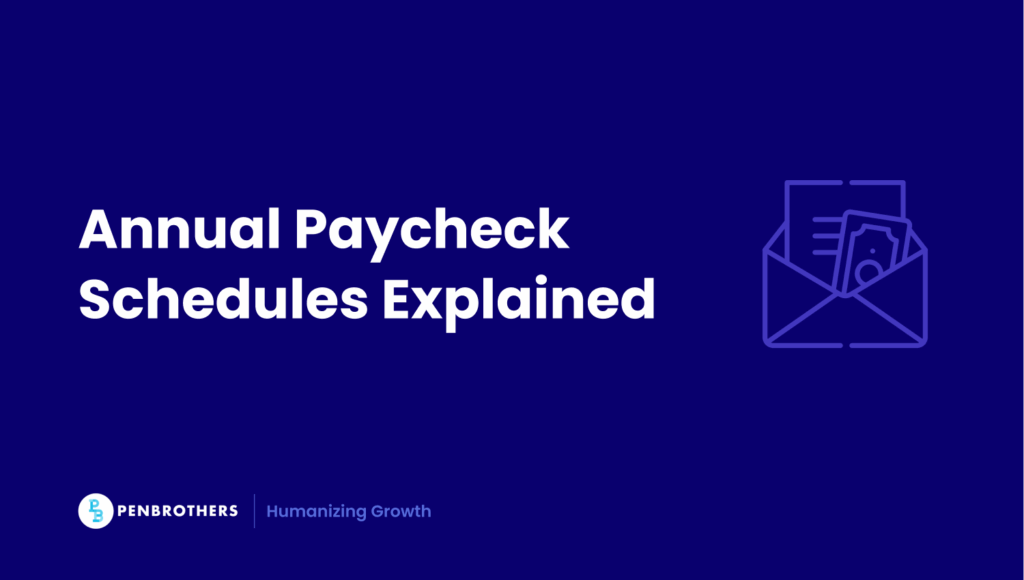Picture this: you log into your bank and see an unexpected “extra” paycheck in July or no paycheck in November. That’s what happens when pay periods don’t line up neatly with the calendar. Whether you’re budgeting for rent, payroll, or taxes, knowing how many paychecks land in a year is crucial, especially if you’re managing global teams or navigating offshore payroll setups.
This guide breaks down pay‑period basics, what to expect in 2025, monthly vs. bi‑weekly nuances, leap year surprises, and how schedules vary worldwide.
Pay Period Basics: What You Need to Know First
Before we dive into how many paychecks land in a year, let’s define two key terms that shape every payroll conversation:
- Pay period is the time frame over which an employee’s work hours or salary entitlements are calculated. This could span a week, two weeks, half a month, or an entire month, depending on your payroll cycle.
- Pay date is the actual day wages are issued. It might fall a few days after the end of the pay period, depending on processing schedules.
Your pay frequency, the rhythm at which you’re paid, is what determines how many paychecks you receive each year. This varies by company, country, and role type.
Why does this matter?
- For employees, it directly impacts cash flow and personal budgeting. A more frequent pay cycle can make it easier to manage day-to-day expenses, while less frequent schedules may require longer planning between deposits.
- For employers, it shapes the entire payroll operation. Pay frequency influences administrative workload, affects compliance with labor regulations, and plays a role in cash flow timing, especially for growing businesses or those managing global teams.
Understanding your pay period structure is a critical first step in financial planning whether you’re receiving paychecks or managing them.
So… How Many Paychecks in a Year?
Let’s answer the big question directly: How many paychecks do employees actually receive in a year? The number depends entirely on your company’s pay frequency. Each pay schedule divides the year differently, affecting everything from budgeting to payroll compliance.
| Pay Frequency | Typical Number of Paychecks per Year | Details |
| Weekly | 52 (occasionally 53) | Employees are paid once every week, usually on the same weekday (e.g., every Friday). In some years, the calendar results in 53 Fridays, leading to an extra paycheck. This occurs roughly every 5–6 years depending on leap years and the weekday the year starts on. |
| Bi-weekly | 26 (occasionally 27) | Paychecks are issued every two weeks, resulting in 26 pay periods in a standard 52-week year. However, in some years, when January 1 and December 31 both fall on your payroll day, you may get a 27th paycheck. This rare occurrence affects budgeting, especially for salaried employees. |
| Semi-monthly | 24 | Paydays fall on two fixed dates per month, typically the 15th and last day. Unlike bi-weekly pay (which moves through the calendar), semi-monthly stays aligned to the month’s dates, so there’s never an “extra” paycheck. This is a popular choice for salaried teams in the US and Philippines. |
| Monthly | 12 | Employees receive one paycheck per month, usually on the same date (e.g., the 30th). While this is the most straightforward schedule to administer, it may be challenging for employees managing weekly expenses, especially in regions with a high cost of living. |
2025 Bi‑weekly Payroll: Will It Be 26 or 27?
Most employees on a bi-weekly pay schedule can expect 26 paychecks in 2025, according to payroll calendars published by ADP and other leading providers. That’s the standard number in a 52-week year when pay is issued every two weeks.
However, 2025 presents a rare calendar alignment that could result in 27 bi-weekly pay periods for some companies.
Here’s why:
- Bi-weekly pay is issued every 14 days. Over 52 weeks, this typically results in 26 pay periods.
- But if the first payday of the year falls on January 1 (a Wednesday) and the final payday lands on December 31, that’s a full 53 weeks, leaving room for one extra pay cycle.
A widely discussed payroll scenario on Reddit’s HR and payroll forums puts it this way:
“I got our 2025 payroll calendar from ADP and it turns out that January 1st 2026 is a payroll Thursday, but New Year’s being a federal holiday that pushes the pay date back to Wednesday, December 31 2025… which means […] there are 27 biweekly pay periods in calendar year 2025”
So while 26 paychecks remains the norm, some payroll schedules, especially those with Thursday or Friday paydays starting the first week of January, could see a 27th payday sneak in.
What Employers Should Do
- Run a payroll calendar simulation for the full year to confirm how many cycles fall within 2025.
- Communicate early with employees if this will affect salary distribution, especially if they’re salaried and annual pay is divided across more periods.
- Adjust budgets to account for the additional payout, if applicable. While the extra check doesn’t increase annual salary (unless adjusted), it does increase cash outflows for that cycle, impacting payroll tax timing and reporting.
This situation isn’t common, but it’s not unheard of either, it tends to occur every 11 years or so. Modeling ahead can help companies avoid unpleasant surprises at year-end.
Weekly vs. Bi‑weekly vs. Semi‑monthly: Which One’s Better?
| Frequency | Employees (Pros / Cons) | Employers (Pros / Cons) |
| Weekly | More frequent income for budgeting; Less stable month-end totals | Easier OT tracking; Higher admin cost, cash-flow demands |
| Bi-weekly | Regular payment, consistent day; Dates rotate monthly, sometimes 3 per month | Lower admin load than weekly; Occasional ‘extra’ pay raises costs |
| Semi-monthly | Same two dates each month; simpler budgeting; Overtime allocation can get messy | Stable cost projection; Harder with variable hours |
| Monthly | Lowest admin overhead; Challenging for those living paycheck-to-paycheck | Easiest for payroll systems and tax compliance; May lower workforce morale |
Decision tip: hourly-centric industries often favor weekly or bi‑weekly, while salaried organizations may go semi‑monthly or monthly for simplicity
What About Leap Years and “Extra” Paychecks?
Extra pay periods happen when:
- A leap year shifts weekday alignments.
- Your payday (e.g., Friday) lines up early Jan 1 or Dec 31.
This can lead to 53 weeks, 27 bi‑weekly pay cycles, or just increased costs if salaries are split across more pays.
Tip: Employers often spread annual salary differently (e.g., prorated monthly during a 27‑cycle year) to avoid unexpected payroll spikes. Communication to employees helps avoid confusion when an extra check lands or a month goes by without one.
Global Payroll Differences: What Varies by Country
Pay frequency isn’t one-size-fits-all, labor laws, cultural expectations, and industry norms vary widely across countries. Here’s a snapshot of how payroll schedules differ globally:
- United States – Bi-weekly pay is the most common setup, used by around 43% of employers. Weekly pay is next at 27%, followed by semi-monthly (19.8%) and monthly (10.3%). The choice often depends on industry (e.g., hourly vs. salaried workers) and state-level labor practices.
- United Kingdom – Monthly pay is the standard, particularly for salaried employees. However, hourly and shift-based workers may still receive weekly or bi-weekly wages depending on sector and contract.
- Australia – The most common payroll schedule is fortnightly (every two weeks), though weekly and monthly arrangements also exist depending on the employer or award agreements.
- Philippines – Semi-monthly pay is the legal norm, typically distributed on the 15th and 30th/31st of the month. This format aligns with Philippine labor regulations and is similar to the US semi-monthly structure, fixed dates simplify income tax computation and deductions.
- Latin America – Most countries legally require monthly pay, often accompanied by a mandatory 13th-month salary as a bonus (e.g., in Brazil, Mexico, Argentina). Some countries like Colombia even split this bonus into two payments across the year.
- EMEA and Asia–Pacific – There’s a broader mix. Monthly and semi-monthly schedules are both prevalent, but semi-monthly is often mandatory for blue-collar or unionized workers in countries like Belgium and Russia, where labor protections emphasize predictable, twice-a-month income.
Quick Compliance Tip for the Philippines: Employers must comply with semi-monthly pay to meet Department of Labor standards. Using fixed pay dates (e.g., 15th and end-of-month) reduces administrative overhead for tax and benefits computation.
Choosing the Right Payroll Schedule (For Employers)
Your payroll schedule isn’t just a finance decision, it’s a strategic lever that affects compliance, operations, employee morale, and even talent retention. Here’s what to consider when choosing the best payroll frequency for your business:
Key Factors to Weigh:
- Company Size & Workforce Type
- Small businesses may prefer monthly or semi-monthly for simplicity.
- Larger or global companies often need varied schedules across regions.
- Hourly workers tend to expect more frequent pay (weekly or bi-weekly), while salaried employees often adapt to monthly.
- Cash Flow & Revenue Cadence
- Align your payroll frequency with your business’s income cycles.
- Bi-weekly payroll can create cash flow pressure if revenue is monthly or seasonal.
- Industry Norms & Cost Considerations
- Weekly payroll is common in industries like retail, hospitality, and construction but increases administrative workload and processing costs.
- Monthly payroll smooths out expenses, especially in stable, salaried environments like tech or consulting.
- Legal & Compliance Requirements
- In the US, state-specific laws govern minimum pay frequency (e.g., California requires at least semi-monthly for most workers).
- In countries like the Philippines, semi-monthly is mandated by labor law. Always check local regulations to avoid penalties.
- Employee Sentiment & Financial Wellness
- More frequent pay (weekly or on-demand) can improve morale, particularly in regions with high living costs.
- A recent PwC 2023 Employee Financial Wellness Survey found that 73% of financially stressed employees said they would be more likely to join or remain with an employer that actively prioritizes their financial well-being. Offering flexible payroll options is one effective way to demonstrate that commitment, and it can be a powerful retention tool.
Pro Tips:
- Use Payroll Calendar Templates
Leverage tools like the ADP 2025 payroll calendar to visualize pay dates across the year and anticipate edge cases (e.g., 27-paycheck years). - Account for Bank Holidays & Weekends
Always ensure pay dates land on working days. Build in early processing for long weekends and national holidays. - Plan for Anomalies
Leap years and bi-weekly schedules can cause extra pay cycles. Communicate changes to your team clearly and early to build trust and avoid confusion.
FAQs
Q: Can employers change pay periods mid‑year?
A: Yes, but check legal notice requirements and potential employee impact, especially in hourly/trade sectors (e.g., FLSA requirements).
Q: Is a 27th paycheck a bonus or split?
A: Usually salary is divided across 27 paydays; it’s not extra income, just a different spread.
Q: Can employees choose pay frequency?
A: Rare. Employers set schedules; flexibility usually reserved for shift- or wage-based systems in union or custom settings.
Q: How many pay periods in a year?
A: Four main schemes, 52, 26/27, 24, or 12. In practice, you’ll fall into one and should model anomalies ahead.
Final Thoughts
If you’re scaling globally or navigating payroll across multiple countries, it’s easy to get lost in compliance, tax obligations, and payout schedules. That’s where Penbrothers comes in.
We help growing businesses manage offshore teams with seamless payroll, compliance peace of mind, and workforce support, so you can focus on growth, not admin.
Let’s build a payroll setup that works wherever your talent is.






